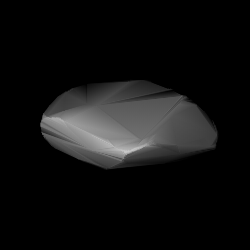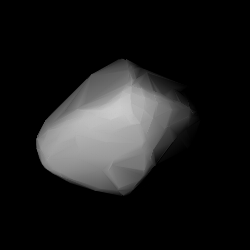Related Research Articles

1743 Schmidt, provisional designation 4109 P-L, is a dark background asteroid from the inner regions of the asteroid belt, approximately 19 kilometers in diameter. It was discovered during the Palomar–Leiden survey on 24 September 1960, by astronomers Ingrid and Cornelis van Houten at Leiden, on photographic plates taken by Tom Gehrels at Palomar Observatory in California. The C-type asteroid has a rotation period of 17.5 hours. It was named for the optician Bernhard Schmidt.
Arago, provisional designation 1923 OT, is a dark asteroid from the outer regions of the asteroid belt, approximately 55 kilometers in diameter. It was discovered on 5 September 1923, by Russian astronomer Sergey Belyavsky at the Simeiz Observatory on the Crimean peninsula. The asteroid was named after French mathematician François Arago.

1039 Sonneberga, provisional designation 1924 TL, is a dark background asteroid, approximately 34 kilometers in diameter, located in the central region of the asteroid belt. It was discovered on 24 November 1924, by German astronomer Max Wolf at Heidelberg Observatory in southwest Germany. The asteroid was named for the German city of Sonneberg, where the Sonneberg Observatory is located.
1041 Asta, provisional designation 1925 FA, is a carbonaceous background asteroid from the outer regions of the asteroid belt, approximately 57 kilometers in diameter. It was discovered on 22 March 1925, by German astronomer Karl Reinmuth at the Heidelberg Observatory in southwest Germany. The asteroid was likely named after Danish actress Asta Nielsen.
6433 Enya, provisional designation 1978 WC, is a stony background asteroid from the inner regions of the asteroid belt, approximately 7 kilometers in diameter. It was discovered on 18 November 1978, by Czech astronomer Antonín Mrkos at the Kleť Observatory in the Czech Republic. It was named for Irish musician Enya.
1096 Reunerta, provisional designation 1928 OB, is an asteroid from the background population of the asteroid belt's central region, approximately 40 kilometers in diameter. It was discovered on 21 July 1928, by astronomer Harry Edwin Wood at the Union Observatory in Johannesburg, South Africa. The asteroid was named after South African engineer Theodore Reunert, supporter of the observatory and friend of the discoverer.
11277 Ballard, provisional designation 1988 TW2, is a Phocaea asteroid from the inner regions of the asteroid belt, approximately 6.3 kilometers (3.9 miles) in diameter. It was discovered on 8 October 1988, by American astronomer couple Carolyn and Eugene Shoemaker at the Palomar Observatory in California. The assumed S-type asteroid has a rotation period of at least 10 hours. It was named for American marine scientist Robert Ballard.
9298 Geake, provisional designation 1985 JM, is a Mitidika asteroid from the central regions of the asteroid belt, approximately 12 kilometers in diameter. It was discovered on 15 May 1985, by American astronomer Edward Bowell at Lowell Observatory's Anderson Mesa Station near Flagstaff, Arizona, United States. The asteroid was named for British astronomer John E. Geake.
1267 Geertruida, provisional designation 1930 HD, is a carbonaceous background asteroid from the inner regions of the asteroid belt, approximately 20 kilometers in diameter. Discovered by astronomer Hendrik van Gent at Johannesburg Observatory in 1930, the asteroid was later named after Geertruid Pels, sister of Dutch astronomer Gerrit Pels.
6255 Kuma, provisional designation 1994 XT, is a carbonaceous asteroid from the central region of the asteroid belt, approximately 22 kilometers in diameter. It was discovered on 5 December 1994, by Japanese astronomer Akimasa Nakamura at Kuma Kogen Astronomical Observatory on the Island of Shikoku, Japan. It was named after the Japanese town of Kumakōgen.
1383 Limburgia, provisional designation 1934 RV, is a carbonaceous asteroid from the outer region of the asteroid belt, approximately 23 kilometers in diameter. It was discovered on 9 September 1934, by Dutch astronomer Hendrik van Gent at the Leiden Southern Station, annex to the Johannesburg Observatory in South Africa. It is named for the Dutch province Limburg.

1444 Pannonia is a carbonaceous background asteroid from the outer region of the asteroid belt, approximately 29 kilometers in diameter. It was discovered on 6 January 1938, by Hungarian astronomer György Kulin at Konkoly Observatory in Budapest, Hungary. It was named after the ancient province of the Roman Empire, Pannonia.
1692 Subbotina, provisional designation 1936 QD, is a dark background asteroid from the central region of the asteroid belt, approximately 37 kilometers in diameter. The carbonaceous Cg-type asteroid has a rotation period of 9.2 hours. It was discovered by Grigory Neujmin at the Crimean Simeiz Observatory in 1936, and later named after Soviet mathematician and astronomer Mikhail Subbotin.
2391 Tomita, provisional designation 1957 AA, is a Nysian asteroid from the inner regions of the asteroid belt, approximately 15 kilometers in diameter. The asteroid was discovered on 9 January 1957, by German astronomer Karl Reinmuth at Heidelberg Observatory in southern Germany. It was named after Japanese astronomer Kōichirō Tomita.
1323 Tugela, provisional designation 1934 LD, is a dark background asteroid from the outer regions of the asteroid belt, approximately 60 kilometers in diameter. It was discovered on 19 May 1934, by South African astronomer Cyril Jackson at the Union Observatory in Johannesburg. The asteroid was named for the Tugela River in western South Africa.
4760 Jia-xiang, provisional designation 1981 GN1, is a background asteroid from the inner regions of the asteroid belt, approximately 5 kilometers (3 miles) in diameter. It was discovered on 1 April 1981, by astronomers at Harvard University's Oak Ridge Observatory in Massachusetts, United States. The presumed stony S-type asteroid was named after Chinese astronomer Zhang Jiaxiang. It has a rotation period of 14.96 hours.

1632 Sieböhme, provisional designation 1941 DF, is an asteroid and relatively slow rotator from the middle region of the asteroid belt, approximately 27 kilometers in diameter. It was discovered on 26 February 1941, by German astronomer Karl Reinmuth at Heidelberg Observatory in southern Germany. It was later named after ARI-astronomer Siegfried Böhme.

1422 Strömgrenia, provisional designation 1936 QF, is a stony Florian asteroid from the inner regions of the asteroid belt, approximately 5.5 kilometers in diameter. It was discovered on 23 August 1936, by German astronomer Karl Reinmuth at Heidelberg Observatory in southern Germany, and named after Swedish-Danish astronomer Svante Elis Strömgren.
15224 Penttilä, provisional designation 1985 JG, is a dark background asteroid from the inner regions of the asteroid belt, approximately 8 kilometers in diameter. It was discovered on 15 May 1985, by American astronomer Edward Bowell at Lowell's Anderson Mesa Station in Arizona, United States. The likely elongated asteroid has a rotation period of 4.4 hours. It was named after planetary scientist Antti Penttilä at the University of Helsinki.
(7563) 1988 BC, provisional designation 1988 BC, is a background asteroid from the central region of the asteroid belt, approximately 16 kilometers in diameter. It was discovered on 16 January 1988, by Japanese amateur astronomer Takuo Kojima at the YGCO Chiyoda Station in the Kantō region of Japan. The asteroid has a rotation period of 6.5 hours.
References
- 1 2 3 4 5 "JPL Small-Body Database Browser: 1303 Luthera (1928 FP)" (2017-11-25 last obs.). Jet Propulsion Laboratory. Archived from the original on 19 August 2020. Retrieved 15 December 2017.
- 1 2 3 Schmadel, Lutz D. (2007). "(1303) Luthera". Dictionary of Minor Planet Names. Springer Berlin Heidelberg. p. 107. doi:10.1007/978-3-540-29925-7_1304. ISBN 978-3-540-00238-3.
- 1 2 3 4 5 6 7 "LCDB Data for (1303) Luthera". Asteroid Lightcurve Database (LCDB). Retrieved 15 December 2017.
- 1 2 "Asteroid 1303 Luthera – Nesvorny HCM Asteroid Families V3.0". Small Bodies Data Ferret. Retrieved 26 October 2019.
- 1 2 Masiero, Joseph R.; Grav, T.; Mainzer, A. K.; Nugent, C. R.; Bauer, J. M.; Stevenson, R.; et al. (August 2014). "Main-belt Asteroids with WISE/NEOWISE: Near-infrared Albedos". The Astrophysical Journal. 791 (2): 11. arXiv: 1406.6645 . Bibcode:2014ApJ...791..121M. doi:10.1088/0004-637X/791/2/121.
- 1 2 3 4 Usui, Fumihiko; Kuroda, Daisuke; Müller, Thomas G.; Hasegawa, Sunao; Ishiguro, Masateru; Ootsubo, Takafumi; et al. (October 2011). "Asteroid Catalog Using Akari: AKARI/IRC Mid-Infrared Asteroid Survey". Publications of the Astronomical Society of Japan. 63 (5): 1117–1138. Bibcode:2011PASJ...63.1117U. doi:10.1093/pasj/63.5.1117. (online, AcuA catalog p. 153)
- 1 2 3 4 Nugent, C. R.; Mainzer, A.; Masiero, J.; Bauer, J.; Cutri, R. M.; Grav, T.; et al. (December 2015). "NEOWISE Reactivation Mission Year One: Preliminary Asteroid Diameters and Albedos". The Astrophysical Journal. 814 (2): 13. arXiv: 1509.02522 . Bibcode:2015ApJ...814..117N. doi:10.1088/0004-637X/814/2/117 . Retrieved 15 December 2017.
- 1 2 3 4 Nugent, C. R.; Mainzer, A.; Bauer, J.; Cutri, R. M.; Kramer, E. A.; Grav, T.; et al. (September 2016). "NEOWISE Reactivation Mission Year Two: Asteroid Diameters and Albedos". The Astronomical Journal. 152 (3): 12. arXiv: 1606.08923 . Bibcode:2016AJ....152...63N. doi: 10.3847/0004-6256/152/3/63 .
- 1 2 3 4 Mainzer, A.; Grav, T.; Masiero, J.; Hand, E.; Bauer, J.; Tholen, D.; et al. (November 2011). "NEOWISE Studies of Spectrophotometrically Classified Asteroids: Preliminary Results". The Astrophysical Journal. 741 (2): 25. arXiv: 1109.6407 . Bibcode:2011ApJ...741...90M. doi:10.1088/0004-637X/741/2/90.
- 1 2 3 4 Masiero, Joseph R.; Mainzer, A. K.; Grav, T.; Bauer, J. M.; Cutri, R. M.; Nugent, C.; et al. (November 2012). "Preliminary Analysis of WISE/NEOWISE 3-Band Cryogenic and Post-cryogenic Observations of Main Belt Asteroids". The Astrophysical Journal Letters. 759 (1): 5. arXiv: 1209.5794 . Bibcode:2012ApJ...759L...8M. doi:10.1088/2041-8205/759/1/L8 . Retrieved 15 December 2017.
- 1 2 Sada, Pedro V. (September 2008). "CCD Photometry of Six Asteroids from the Universidad de Monterry Observatory". The Minor Planet Bulletin. 35 (3): 105–107. Bibcode:2008MPBu...35..105S. ISSN 1052-8091 . Retrieved 15 December 2017.
- 1 2 Behrend, Raoul. "Asteroids and comets rotation curves – (1303) Luthera". Geneva Observatory. Retrieved 15 December 2017.
- 1 2 "1303 Luthera (1928 FP)". Minor Planet Center. Retrieved 15 December 2017.
- 1 2 Nesvorný, D.; Broz, M.; Carruba, V. (December 2014). "Identification and Dynamical Properties of Asteroid Families". Asteroids IV. pp. 297–321. arXiv: 1502.01628 . Bibcode:2015aste.book..297N. doi:10.2458/azu_uapress_9780816532131-ch016. ISBN 9780816532131.